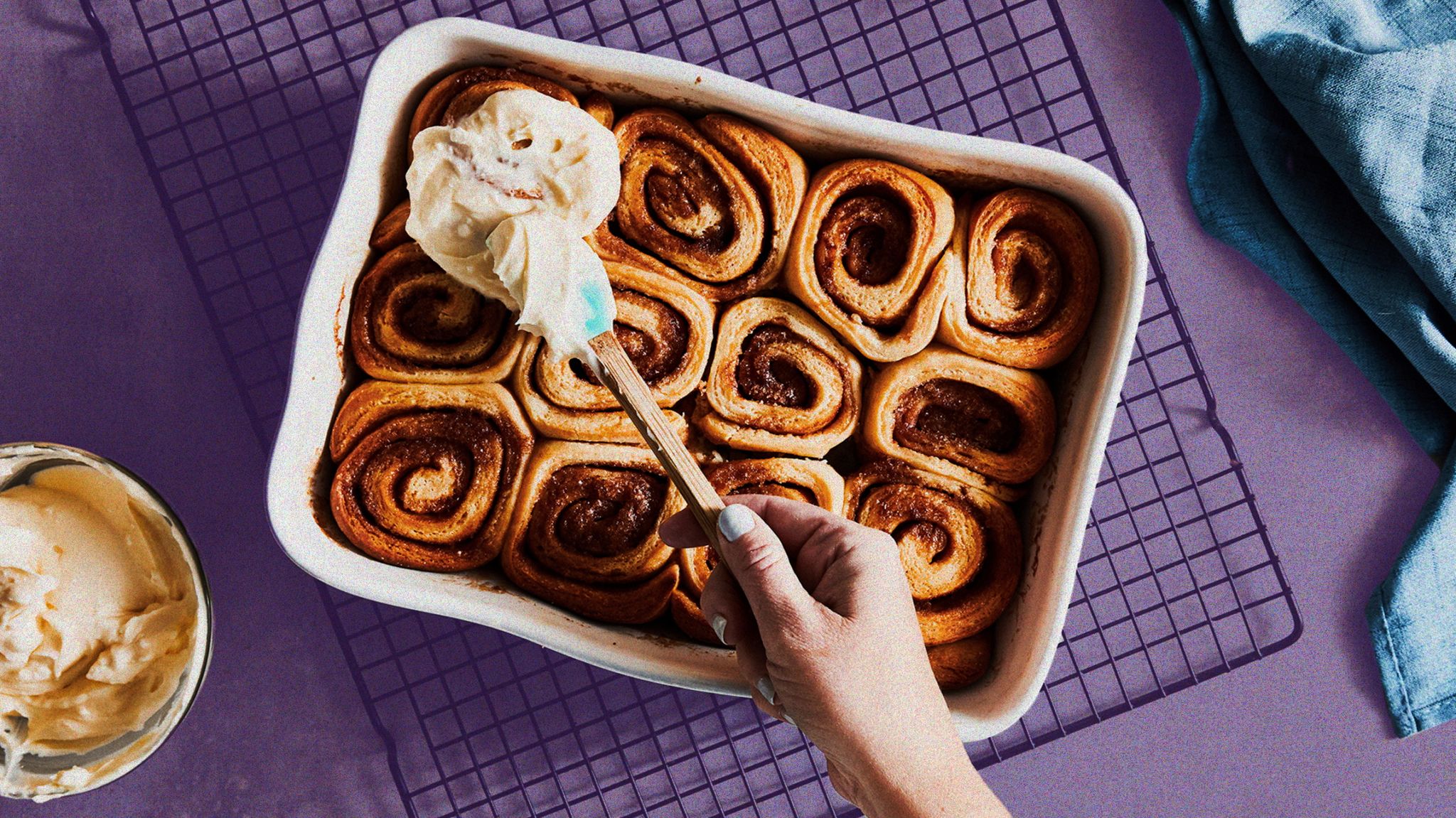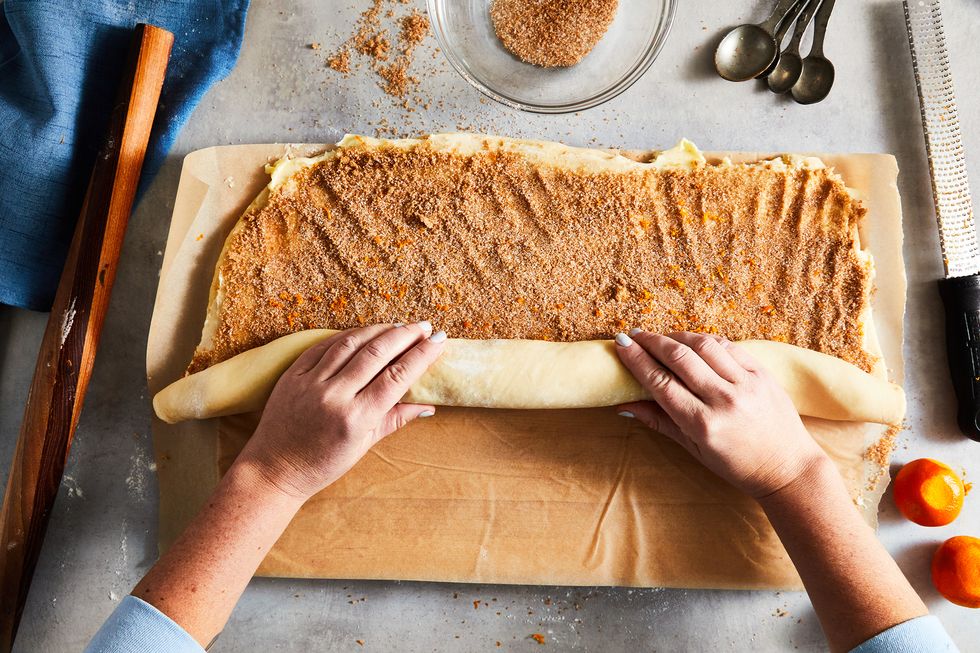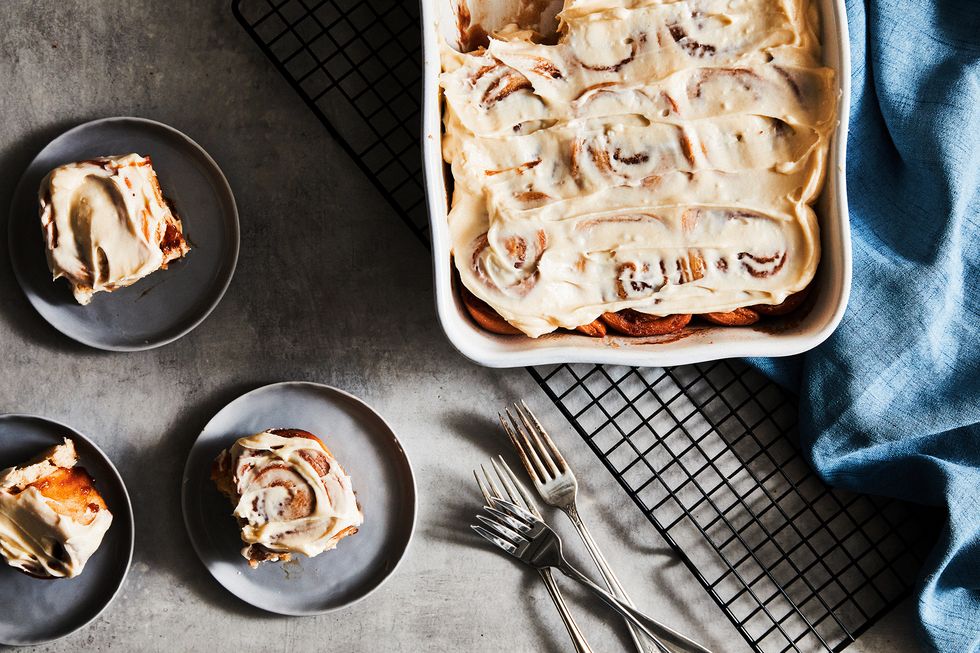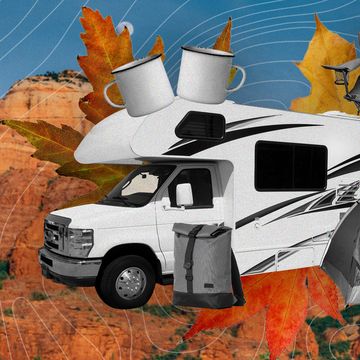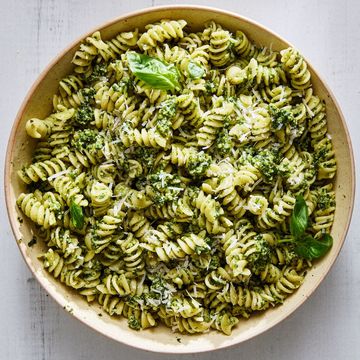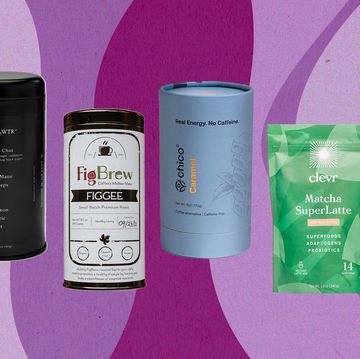Every family has their holiday baking tradition. Mine is cinnamon rolls. I’m not sure if it’s the smell, taste, or high demand that keeps me coming back to the sweet breakfast buns year after year.
Cinnamon rolls have become one of my favorite things to make around the holidays. Preparing this sweet treat from scratch requires a time commitment, but the result is well worth the effort. There are three components to a cinnamon roll:
- Dough: The slightly sweetened yeasted dough is prepared, proofed, then rolled with a rolling pin into a rectangle to be covered with a filling.
- Filling: the gooey cinnamon sugar that’s inside the rolls. The prepared dough is slathered with butter and cinnamon sugar before being rolled up and cut.
- Icing: The whipped creamy topping is applied to freshly baked rolls. Made with sugar, it can be thin and runny or thick and fluffy.
To kick things off, you will start with making the dough, which requires yeast. For newbies, look for active dry yeast. It’s an instant yeast that’s easy to find at the grocery store. It typically comes in a strip with three packages. Always refer to the package instructions. Usually with active dry, you stir yeast into a warm liquid (100° to 110° F). It’s important to take the extra 30 seconds to check the temperature of the liquid. If it’s too cold, the yeast will not activate. If it’s too hot, it will kill the yeast. Both scenarios will create an epic failure.
Once the dough ingredients are mixed, you’ll need to knead. The action works the gluten, which is what gives cinnamon rolls structure and texture. You can knead the dough using a dough hook and an electric mixer or with a bit of elbow grease on a floured surface. Just be careful not to overwork the dough.
Next up is proofing, which is the process that activates the yeast and makes the dough rise. The dough is typically covered with a towel or plastic wrap in an oiled bowl and rests in a warm spot. The actual time it takes to proof can vary based on several factors, including temperature, time of year, location, and humidity. If you have a fancy oven with a proof setting, now is the time to test it out. Otherwise, a warm spot in a sunny window or even near a heat vent will do the trick.
When the dough is ready, it’s rolled out onto a floured surface, covered with salted butter, and topped with cinnamon sugar. From there, it’s shaped into a tube and cut into 12 pieces or rolls, which are transferred to a 9-inch-by-13-inch dish and proofed again before baking. Once baked, they are topped with icing and served.
If you want to bake your cinnamon rolls the next morning, cover in plastic wrap and refrigerate (for up to 24 hours) after transferring the cut rolls to the baking dish. The next morning, the cinnamon rolls will need to come to room temperature before the second proof. That whole process takes about 90 minutes. Then, bake and frost as indicated in the recipe below.
Cinnamon Rolls
Prep time: 1 hour. Rest time: 90 minutes. Bake time: 25 to 30 minutes. Yield: 1 dozen cinnamon rolls.
Ingredients
For the dough:
- 1 cup milk, warmed to 100° to 110° F
- 1 (.25 ounce) package active dry yeast (about 2¼ teaspoons)
- 1 egg plus 1 egg yolk, room temperature
- ¼ cup vegetable oil
- ½ cup sugar
- 1 tablespoon vanilla extract
- ½ teaspoon salt
- 3½ to 4½ cups all-purpose flour
For the filling:
- 8 tablespoons salted softened butter, divided
- ½ cup granulated sugar
- ½ cup brown sugar
- 1 tablespoon cinnamon
- 1 tablespoon grated orange peel
For the frosting:
- 8 ounces cream cheese, softened
- 4 tablespoons butter, softened
- 2 tablespoons fresh orange juice
- 1 teaspoon vanilla
- 1 cup powdered sugar
Instructions
- Warm the milk to 110° F. Pour the yeast on top, and let rest for about 3 minutes.
- In a large mixing bowl, mix egg, egg yolk, sugar, oil, vanilla, and salt. Mix in yeast/milk mixture, then add 3½ cups flour. Mix by hand, then let rest for 5 minutes.
- Add an additional ¼ cup to ½ cup flour and knead the dough using the dough hook on an electric mixer or by hand on a floured surface until the dough is tacky and elastic, about 5 to 7 minutes. If the dough seems too sticky to work, add additional flour by the tablespoon, gradually.
- Transfer to a well-oiled bowl. Cover with plastic and let rest in a warm space until doubled in size, about 45 minutes.
- While the dough is proofing, prepare the filling by combining both sugars and cinnamon. Use 1 tablespoon butter to grease a 9-inch-by-13-inch baking dish.
- Roll out the dough onto a floured surface into a 12-inch-by-24-inch rectangle. Spread the remaining 7 tablespoons of butter evenly across the surface. Sprinkle cinnamon sugar on top. Then, using your hands, pat the sugar mixture into the butter. Sprinkle with grated orange peel.
- Starting at the bottom, tightly roll the dough into a tube. Cut the tube into 12 even pieces and transfer to the prepared 9-inch-by-13-inch pan. Cover tightly with plastic wrap and let rest in a warm place until full and fluffy, about 45 minutes.
- Preheat oven to 350° F. Bake proofed rolls for 25 to 30 minutes or until golden.
- Prepare the icing while the rolls are baking: Combine cream cheese, butter, orange juice, and vanilla in a mixer bowl. Beat on medium speed until combined and smooth. With the mixer on low, gradually add the powdered sugar. Increase to medium high and beat for one minute.
- Spread frosting on top of cinnamon rolls. Serve warm. Store leftovers loosely covered in the refrigerator for up to two days. Reheat before serving.
Adrienne Blumthal is a formally trained pastry chef, recipe developer, and food stylist based in Chicago.
Get Shondaland directly in your inbox: SUBSCRIBE TODAY
